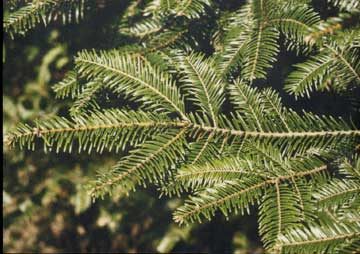
Standard
English Name(s): amabilis
or Pacific silver fir (A. amabilis), grand fir (Abies grandis),
and alpine or subalpine fir (A. lasiocarpa)
Local English Name(s) (if different from above): balsam, balsam
fir; white fir (grand fir)
Scientific Name(s): Abies amabilis (Dougl. ex Loud.) Forbes
(amabilis or Pacific silver fir), A. grandis (Dougl. ex D. Don
in Lamb.) Lindl. (grand fir), and A. lasiocarpa (Hook.) Nutt.
(subalpine or alpine fir)
Upriver Halkomelem Name(s):
Downriver Halkomelem Name(s): t’a’xwulhp (tree)
Island Halkomelem Name(s):
t’a’xw ("balsam" - bark and/or pitch), t’a’xwulhp
(tree) ![]()
Description, Habitat,
Ecology, & Distribution:
Amabilis fir, grand fir (pictured), and
subalpine fir are tall, flat-needled, cone-bearing trees. Amabilis fir
grows most commonly in moist forest sites, on deep, well-drained soils
along most of the coastal region of the province. Grand fir grows in
middle- to upper-elevation coniferous forests along a more restricted
portion of the southern coast. It is often associated with amabilis
fir. Subalpine firs occur at higher elevations within the Island Halkomelem
and Upriver Halkomelem territories. Most or all of the ethnobotanical
data provided here may refer to grand fir rather than amabilis fir.
Upriver Halkomelem Cultural
Role(s):
Downriver Halkomelem Cultural Role(s):
The boughs of grand fir were used to treat
boils.
Island Halkomelem Cultural
Role(s):
Fir trees (probably both species listed),
known locally as "balsam," have pitchy bark that may be used for medicinal
purposes.